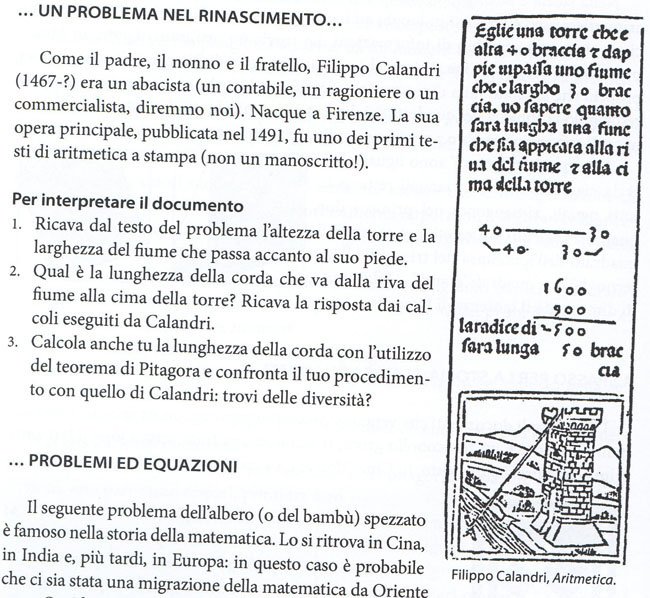- About MAA
- Membership
- MAA Publications
- Periodicals
- Blogs
- MAA Book Series
- MAA Press (an imprint of the AMS)
- MAA Notes
- MAA Reviews
- Mathematical Communication
- Information for Libraries
- Author Resources
- Advertise with MAA
- Meetings
- Competitions
- Programs
- Communities
- MAA Sections
- SIGMAA
- MAA Connect
- Students
- MAA Awards
- Awards Booklets
- Writing Awards
- Teaching Awards
- Service Awards
- Research Awards
- Lecture Awards
- Putnam Competition Individual and Team Winners
- D. E. Shaw Group AMC 8 Awards & Certificates
- Maryam Mirzakhani AMC 10 A Awards & Certificates
- Two Sigma AMC 10 B Awards & Certificates
- Jane Street AMC 12 A Awards & Certificates
- Akamai AMC 12 B Awards & Certificates
- High School Teachers
- News
You are here
Introducing the History of Mathematics: An Italian Experience Using Original Documents - Sample Excerpt

Translation:
There is a tower that is 40 ells high and near the base flows a river that is 30 ells wide. We want to know how long a rope is that starts from the riverside and ends at the top of the tower.
… A PROBLEM IN THE RENAISSANCE…
Like his grandfather, father and brother, Filippo Calandri (1467-?) was an abacist (a book-keeper, an accountant or a business expert as we would say). He was born in Florence. His masterpiece published in 1491 was one of the first printed arithmetic books (not a manuscript!).
To interpret the document
- In the text of the problem find both the tower height and the width of the river flowing near the base of the tower.
- What is the length of the rope that starts from the riverside and ends at the top of the tower? Find the answer in Calandri’s calculations.
- Calculate the rope length by means of the Pythagorean theorem and compare your procedure with Calandri’s procedure: do you find any differences?
Discussion from the teachers' volume:
… A PROBLEM IN THE RENAISSANCE…
Calandri’s problem about the rope length provides an opportunity to interpret a primary mathematical source to students who have a certain ability in numerical applications of the theorem. Students will be able to deduce the meaning of some words from the context. Other words may remain obscure but this shouldn’t impede analysis of the rest of the document. The figure will also help find both the data and the answers of the problem. We may give the student complementary notes on the lack of operation symbols (in the part that concludes the first chapter you can find information about when addition, subtraction, and square root symbols entered common use).
Adriano Dematte (Univ. of Genoa), "Introducing the History of Mathematics: An Italian Experience Using Original Documents - Sample Excerpt," Convergence (February 2010), DOI:10.4169/loci002856




